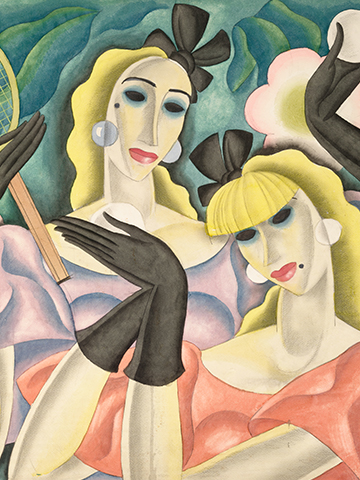“The Lavender Palette” at the Cascadia Museum in Edmonds offers important lessons in art and history.
Written by Gale Fiege, Published by Hearldnet on Thursday, October 24.
A wall of jail mugshots — men arrested for homosexuality — sets the stage for the new exhibition opening today at Cascadia Art Museum in Edmonds.
“The Lavender Palette: Gay Culture and the Art of Washington State” is a packed art show and a powerful history lesson.
Museum curator David F. Martin has put together artwork by dozens of gay men and women who often, just a few short decades ago, had to hide who they were in order to express themselves artistically.
“The Lavender Palette” is a groundbreaking exhibition (a first-of-its-kind, Martin says) that explores how the state’s artistic culture was shaped by the Northwest’s gay artists and how they brought national and international attention to our region.
Most of the works presented in “The Lavender” have never been seen before, making the exhibition a must-see. When the exhibit closes Jan. 26, much of the art will be returned to private collections.
All deceased now, the featured artists include Edmonds native Guy Anderson, one-time Woodway resident Morris Graves, Leo Kenney, Mark Tobey, Delbert J. McBride, Mac Harshberger, Sarah Spurgeon, Thomas Handforth, ceramicist Virginia Weisel, Malcolm Roberts, illustrator Richard Bennett, Ward Corley and Orre Nelson Nobles.
Nobles, a teacher who established the artist colony Olympus Manor on Hood Canal, kept diaries, as many did in the early 1900s. But his love life was written in code to hide that part of his life.
Some gay artists from our region married into hetrosexual relationships and even had children in hopes of keeping their homosexuality closeted. Many served in the military. Others traveled to countries where being gay wasn’t seen as immoral.
Cowlitz/Quinault artist Del McBride’s work was preserved by his family, whereas the nieces and nephews of other gay artists did not often keep sketches of their uncles’ lovers.
Perhaps the saddest story illustrated in the exhibit is that of Lionel Pries, the head of the University of Washington architecture department in the 1920s and a first-class watercolorist. Arrested for sodomy in a Seattle Police Department sting, Pries lost his job “and everything,” Martin said.
Some of our favorite works in “The Lavender Palette” include:
■ Leo Kenney’s striking “Night Blooming Vessel” from 1956.
■ Leon Derbyshire’s “Looking West from First Hill” — a beautiful look at Smith Tower in downtown Seattle. After Derbyshire, who was beaten many times for being gay, died in 1974, a relative sold most of his paintings at a yard sale.
■ Sedro-Woolley’s Sherrill van Cott’s gouaches.
■ The Morris Graves painting “Preening Sparrow” — which was featured in the famous Life magazine story about Northwest School artists Anderson, Graves, Tobey and their straight friend Kenneth Callahan.
■ An early Mark Tobey, “Skid Road Philosophy,” which hasn’t been seen since the 1940s.
■ A 1937 Works Progress Administration commission by Malcolm Roberts, “Fisherman No. 1,” a mosaic on loan from the Smithsonian in Washington, D.C.
■ Mac Harshberger’s illustrations for “Loose Lyrics of Lovely Ladies,” for his boyfriend, Holland Robinson’s, sheet music from the 1920s. Cornish College of the Arts piano professor Peter Mack offers a concert (on the piano donated by Edmonds’ Rick Steves) of Robinson’s songs at 6 p.m. Saturday at the museum. Cost is $18 for non-members. Other works to be performed by Mack and baritone Dana Belkholm include those by Maurice Ravel, Reynaldo Hahn and Nadia Boulanger.
Because of the homoerotic content of some pieces, the third room in the exhibit will be curtained off and available only to those age 18 and older. The room includes drawings and photos and lots of nude male studies.
Lots of sadness and lonesome beauty can be found in each room, but be sure to enjoy the humor as well.
Martin and his museum crew have carefully amassed interesting historic addendum to the stories told by the paintings on the walls. Pull out the drawers in the cabinets in each room to learn more about the artists.
Martin’s accompanying catalog (after 30 years of research) won’t be available until late December or early January. Because there is so much to see and take in, the exhibit deserves more than one look, so consider a second visit when the book is is out.
“I hope young gay people come to see the show,” Martin said. “I want them to realize they can have a good life. I want people to know this history, and I want to encourage gay artists to continue to make contributions to our culture here.”


